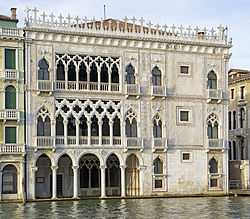House of Contarini


.jpg)
Contarini is a noted Venetian family, from which eight Doges to the Republic of Venice emerged, as well as other notables.
Notable members
- Domenico I Contarini (d. 1071), Doge of Venice 1043-71
- Enrico Contarini (d. 1108), Bishop of Castello 1074-1108
- Jacopo Contarini (1194–1280), Doge of Venice
- Andrea Contarini (died 1382), Doge of Venice
- Bartolomeo Contarini (15th century), governor of the Duchy of Athens for Francesco I Acciaioli
- Ambrogio Contarini (1429–1499), diplomat
- Gasparo Contarini (1483–1542), cardinal and diplomat
- Paolo and Francesco Contarini, who commissioned the Villa Contarini.
- Giovanni Contarini (1549–1605), painter of the Venetian School
- Giovanni Matteo Contarini (died 1507), cartographer
- Contarini-Rosselli map
- Giacomo Contarini, Venetian mathematician
- Maffio Contarini, (died 1460), Patriarch of Venice
- Francesco Contarini (1556–1624), Doge of Venice 1623-24
- Nicolò Contarini (1553–1631), Doge of Venice 1630-31
- Carlo Contarini (1580–1656), Doge of Venice 1655-56
- Domenico II Contarini (1585–1675), Doge of Venice 1659-75
- Alvise Contarini (1597–1651), diplomat who represented Venice at the Congress of Münster
- Alvise Contarini (1601–1684), Doge of Venice 1676-84
Family
The House of Contarini was one of the oldest founding families of the Venetian Republic, and were and remain through extended family consanguinity present in the Veneto's population, represented in over twenty auxiliary and cadet noble branches that include ranks currently among European sovereign, royal and aristocratic descendants. 960 AD marks the first historically verified documentation of the Contarini, with Domenico hailed as the first Contarini-born Doge. By 1797, when the most recent Doge reigned, the family had produced eight Doges. The Venetian Republic, in one form or another, lasted as a functioning independent state for over 1500 years until Napoleon's march into Venice sounded its demise.[1]
The Contarini led the Venetian Republic forward through ever changing ages and commensurate with ample changes in trade, technology, trade: both import and exports, science, religion, art, banking and finance as well as in diplomacy and war. Many wealthy Venetians, such as the Contarini, enjoyed the monetary and health benefits wrought from, for example, the spice trade, which facilitated longevity, a fundamental requirement for assumption of the role of Doge, since the position mandated that a Doge, “must be an octogenarian who commands health, wealth and wisdom”.
Andrea Palladio, who was employed by the Contarini and their relatives, designed several of the most outstanding neo-classical structures in the Veneto’s environs. Importantly, his works satisfied his clients, which, full-circle, he had helped to create. Many such works are found to have often favored a minimalist, if neo-classical, dialog among their design elements. A passion for purity of line, scale and proportion were fundamental to and codified in Palladio's I quattro libri dell'architettura, detailing vital points of design interest for architecture and decoration enthusiasts and professionals, and remains used by architecture students even today.
See also
- Ca' d'Oro, Venice
- Palazzo Contarini del Bovolo, Venice
- Villa Contarini in Piazzola sul Brenta
References
This article incorporates text from a publication now in the public domain: Wood, James, ed. (1907). "article name needed". The Nuttall Encyclopædia. London and New York: Frederick Warne.
- ↑ Norwich, John Julius (1982). A History of Venice. New York: Alfred A. Knopf.